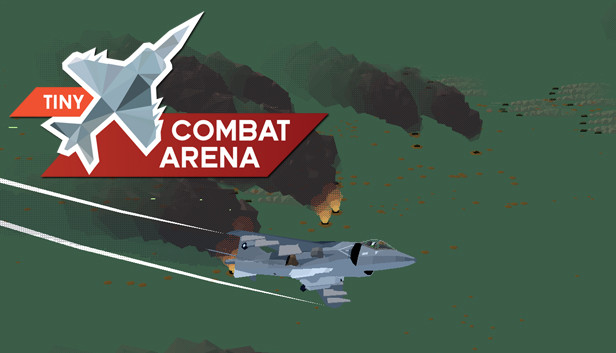Overview
Current version of this guide was published on 2022-02-26 and pertains to version 0.8.1.6 of Tiny Combat Arena.
TLDR
- The nozzles help you stay airborne at lower airspeeds than possible otherwise (including down to zero airspeed: hovering)
- Lower airspeeds are most useful during take-off and landing
- Change nozzle angle gradually and watch your HUD’s velocity vector. Be warned the vector will jump around more as your airspeed approaches a hover.
I’m going to start with some basic aerodynamics, which may be dry if you already understand the theory. Feel free to skim, but I pepper the basics with comments that may be relevant later.
Thrust and Lift vs Gravity
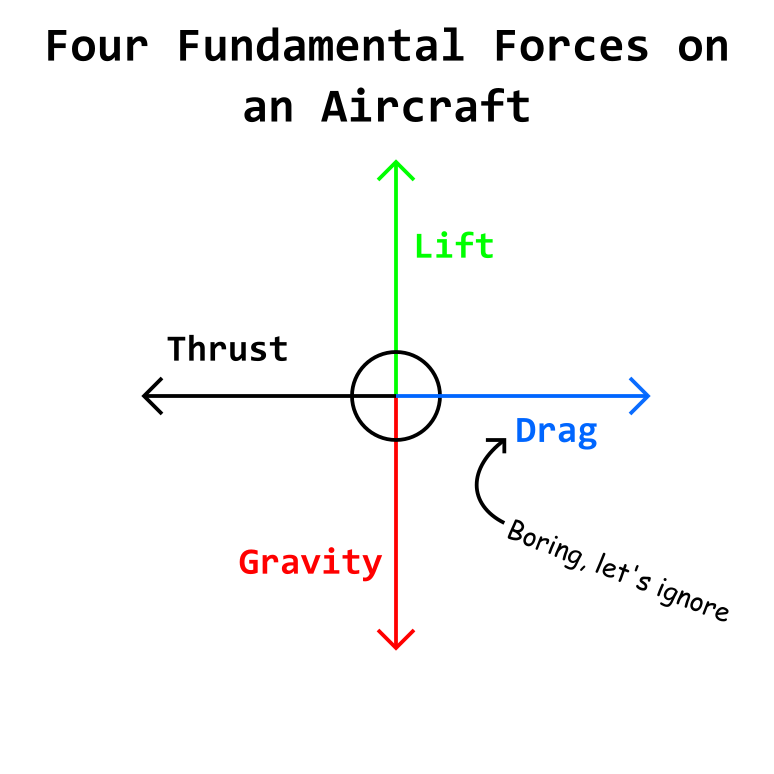
Thrust being the force generated by the engines on the aircraft, which are constantly pushing against the air in order to propel the aircraft along the vector of thrust—the direction the engines are pointing, which in most aircraft is “directly forward, through the middle of the aircraft.”
Lift being the force generated by the surface and volume of the aircraft (but mostly the wings), which is constantly pushing against and being pulled by the air the aircraft is flying through in order to propel the aircraft along the vector of lift. The vector of lift is a bit more complicated, because any good aircraft has parts that manipulate the direction of lift in order to turn, roll, pitch and move around. But for simplicity, it’s usually “pointing straight up, through the middle of the aircraft.”
Lift relies on airspeed to exist, because the aircraft can’t push against or be pulled by the air unless it (or the air) is moving. Lift decreases as airspeed decreases, and disappears entirely when airspeed is zero.
Gravity is the force of the mass of your aircraft trying to merge with the mass of the Earth and is affected by both of them. The heavier your aircraft, the more force applied by gravity. It’s always in the direction “straight down, towards the centre of the earth.”
Staying in the Air
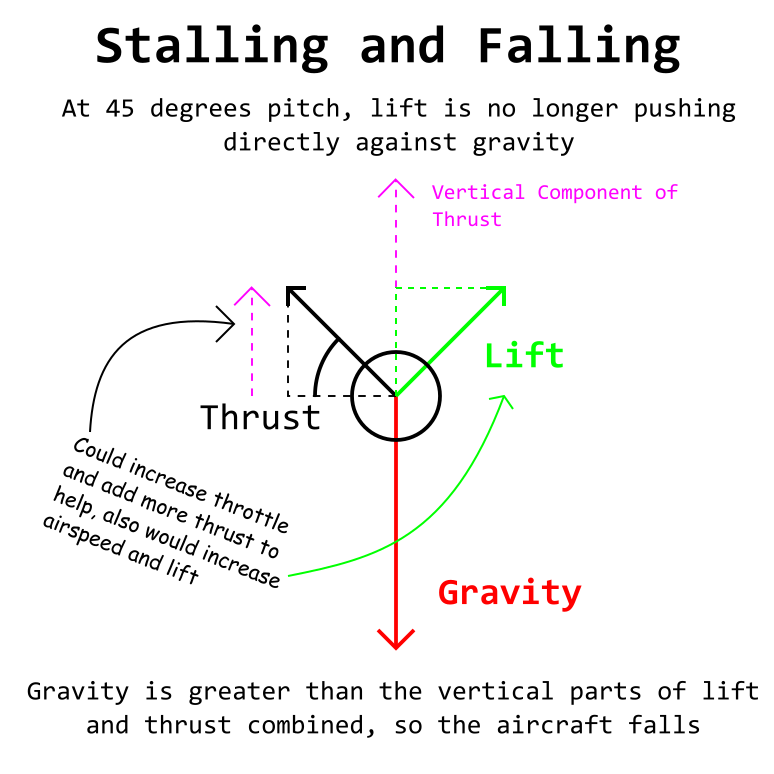
But that’s where “most aircraft, most of the time,” becomes important. You have a second major force, thrust, which you can use to also fight gravity. In the extreme case, picture something like a rocket heading to space. They don’t usually have significant wings, so the way they fight gravity and climb is with lots and lots of thrust. You can also try to fight gravity by pointing your aircraft directly up and cranking the engines to the max. It’s just that in most aircraft, the engines simply aren’t made to produce more thrust than the force of gravity. The “Thrust-to-Weight ratio” or TWR is a measurement that determines this. If the TWR is less than 1, then the aircraft does not have enough thrust to climb vertically like a rocket (at least not for an indefinite length of time; you will lose airspeed and eventually start falling). If the TWR is equal to 1, then the aircraft should neither climb nor fall when trying to climb vertically. Unfortunately, that’s no help for getting you off the ground, since a TWR = 1 means you stay on the ground and just waste a bunch of fuel. You need a TWR greater than 1 to climb vertically like a rocket.
There’s a big range in TWR among aircraft. Most civilian aircraft operate around 0.2-0.3 TWR. The high-end of current military aircraft are speculated to cap out around 1.15. The Harrier sits around 1.1 (varying with weight, however). Tiny Combat Arena displays the current TWR in the Harrier cockpit.
Between the Two Extremes of Thrust and Lift
- Aircraft flying straight and level, using entirely lift to counter gravity
- Aircraft pointing vertically, using entirely thrust to counter gravity
You can obviously mix the two forces to achieve the same goal, “staying in the air”. In fact, most aircraft do this while climbing. You pitch the nose up somewhere between 3 and 10 degrees (or more, if you are feeling aggressive), and the thrust of the engines starts to assist lift in climbing. Technically lift also increases because of the angle-of-attack of the wings, but I’m going to omit further discussion of that here.
And, by mixing the forces, you can reduce the stall speed. If your stall speed is lower, you can safely fly at much lower airspeeds. Lower airspeed is a good thing in certain situations, which we’ll cover later.
Thrust Vectoring and Nozzles
So, what if—instead of keeping the thrust vector pointed “directly forward, through the middle of the aircraft” and turning the aircraft to point it around—you could change the thrust vector directly and keep the aircraft pointed in the same direction as usual? As a verb, this is called “thrust vectoring”, and the Harrier accomplishes it by rotating nozzles.
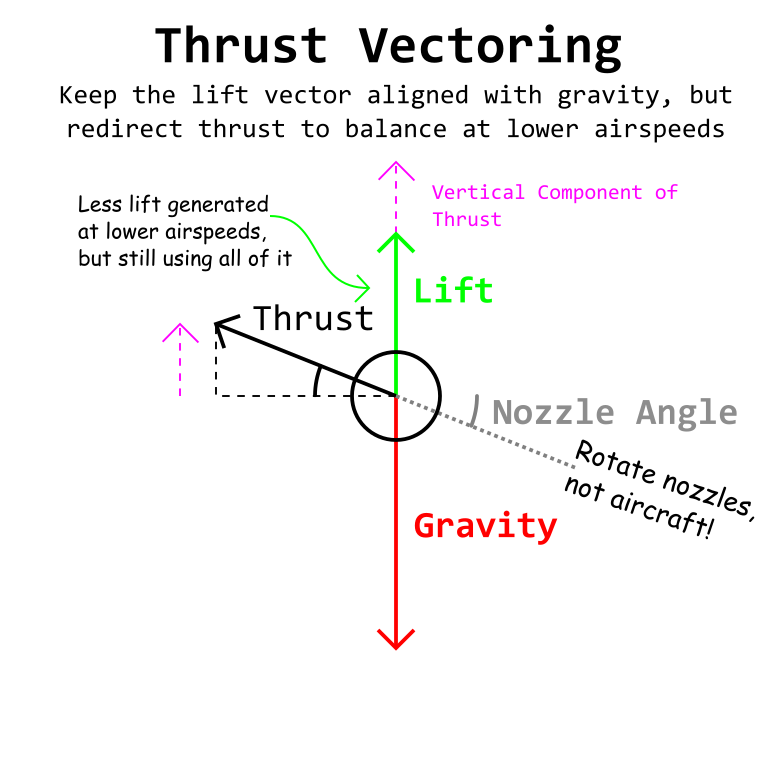
These nozzles are mounted on axes that rotate vertically. 0 degrees is “directly forward, through the middle of the aircraft”, with 90 degrees being “pointing straight down, through the middle of the aircraft.” But they also go a little further than 90 degrees. In Tiny Combat Arena, this maximum is 100 degrees and actually points them very slightly forward. The effect is to add a bit of “backwards” push, while still fighting gravity.
With thrust vectoring, you can accomplish the same vertical thrust as “stand the aircraft on its tail” without all the negatives. And you can obviously swing the nozzles at any direction in between.
Low-Airspeed Flight
You’ll also want to practice the opposite, which is rotating the nozzles back up in a controlled fashion. Remember that your thrust angle is what’s keeping you from stalling at those lower-than-usual airspeeds. You need to keep airspeed above stall speed at all times, therefore you need to raise airspeed higher first, then raise nozzle angle (raising stall speed). This second practice is more difficult and dangerous than the first, so if you found the “rotating down” hard, take this practice even more slowly and carefully.
So why do you want to fly at a lower airspeed? If you’re interested in the Harrier, it’s probably because you’ve heard it can hover in place and land vertically. A hover is just “zero airspeed” flight, so practicing getting closer-and-closer to zero will get you closer and closer to being ready to hover. But you don’t need to come to a full hover to have a much easier time landing, because landing an aircraft is all about safely reducing the airspeed to zero on the ground. The less airspeed you have when you touch the ground, the easier it is to come to a stop and the less space you need to do it.
Short and Vertical Takeoff
But, unlike when you’re in the air, you technically have no “stall speed” for the duration your wheels are on the ground. You can’t fall out of the sky, because you’re already on the ground. Thus, with anything other than a true vertical take-off, there’s no advantage to have the nozzles pointed down until you actually try to get into the air. In fact, you want to have the nozzles pointed mostly forwards, because that produces the airspeed the quickest. So any nozzle-assisted, short takeoff (other than directly vertical) typically proceeds by:
- Nozzles level (0 degrees or 10 degrees IRL, because the nozzles will damage the flaps)
- Throttle up to max
- Wait for airspeed to exceed the stall speed at the nozzle angle you wish to take off
- The above would be calculated ahead of time using charts and math, but you should get the feel for it by practicing low-airspeed flight
- Rotate the nozzles to the angle you need. Ensure you lift off the ground as expected (if not, cut throttle and slam the brakes)
- Follow the procedure you practiced for raising your nozzles/airspeed (and remember to raise the gear and flaps)
Hovering
Those caveats aside, you can definitely hover successfully (under the appropriate circumstances) in Tiny Combat Arena, and use that hover to either takeoff or land vertically. But first and foremost, verify that the TWR value displayed in the cockpit is greater than 1. In real life, many combat loadouts are too heavy to takeoff vertically. In Tiny Combat Arena (as of writing this guide), each loadout is optimized for a specific TWR, and so you should choose a takeoff (or landing) procedure appropriate for that loadout. If the TWR is 1.05 or better, you’re probably fit to take off vertically. But too close 1 or under 1, you must not perform a pure vertical takeoff into a hover.
To hover in place, you need a nozzle angle that points directly into the ground. However, this is not necessarily 90 degrees (but it can be). It depends on the pitch of the aircraft. In fact, the Harrier’s landing gear IRL is mounted such that the Harrier pitches up. The angle is not precisely marked in TCA, but my testing suggests it’s somewhere between 3 and 6 degrees nose up (6 being the IRL value, but testing suggesting it’s lower, as of the writing of this guide. This might be to make it easier on new players, who try to use 90 degrees). You need to use an angle of somewhere around 84-87 degrees if you are taking off, or if you want to perform a perfect, 4-point landing. The HUD has a ‘W’-shaped symbol on it call the ‘waterline’ symbol. The waterline indicator shows where the nose is pointing.
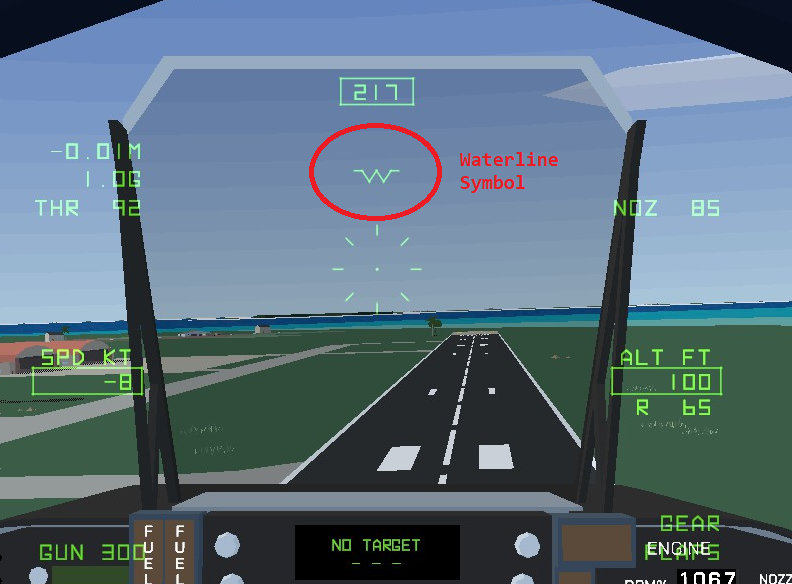 The nozzle angle is relative to that symbol, so if the waterline indicator shows 3 degrees pitch up from the horizon, a direct nozzle angle to the ground is 87 degrees. If the waterline indicator is directly on the horizon, a direct nozzle angle to the ground is 90 degrees. If your nozzle angle doesn’t point directly into the ground, you will slide forwards or backwards instead of hovering in place. If you can’t control that slide by reacting fast enough with pitch, roll, and nozzle controls, you will do a flip. Every new Harrier player does a flip, so don’t feel bad about it! Now you hopefully know why it happens and how to prevent it.
The nozzle angle is relative to that symbol, so if the waterline indicator shows 3 degrees pitch up from the horizon, a direct nozzle angle to the ground is 87 degrees. If the waterline indicator is directly on the horizon, a direct nozzle angle to the ground is 90 degrees. If your nozzle angle doesn’t point directly into the ground, you will slide forwards or backwards instead of hovering in place. If you can’t control that slide by reacting fast enough with pitch, roll, and nozzle controls, you will do a flip. Every new Harrier player does a flip, so don’t feel bad about it! Now you hopefully know why it happens and how to prevent it.
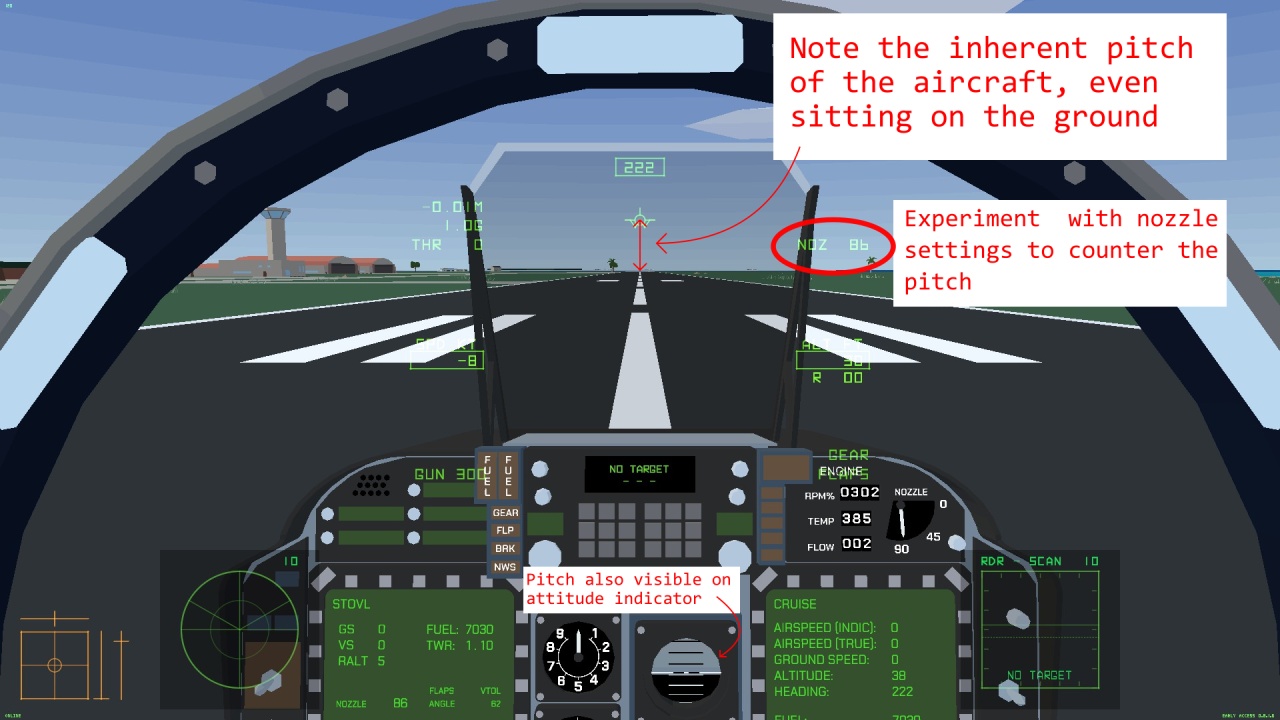
Hovering is aerodynamically bad. The Harrier is designed to do it, with things like a reaction-control system to compensate for control stall during hovering, but it will always be aerodynamically worse than flying with airspeed. You want to spend as little time hovering as possible. That means, on takeoff, you want to start moving forwards and gaining airspeed as soon as you’re clear of obstacles on the ground, and on landing, you only want to start to hover once you’re directly over where you intend to land. In fact, you may want to actually do an extremely short, rolling landing instead of a true hover, if the space allows it. Just try entering a “hover” with 20-40 knots airspeed and set the Harrier down. It will still stop in place on the ground, but will feel much easier to control than if you drop the airspeed to zero.
